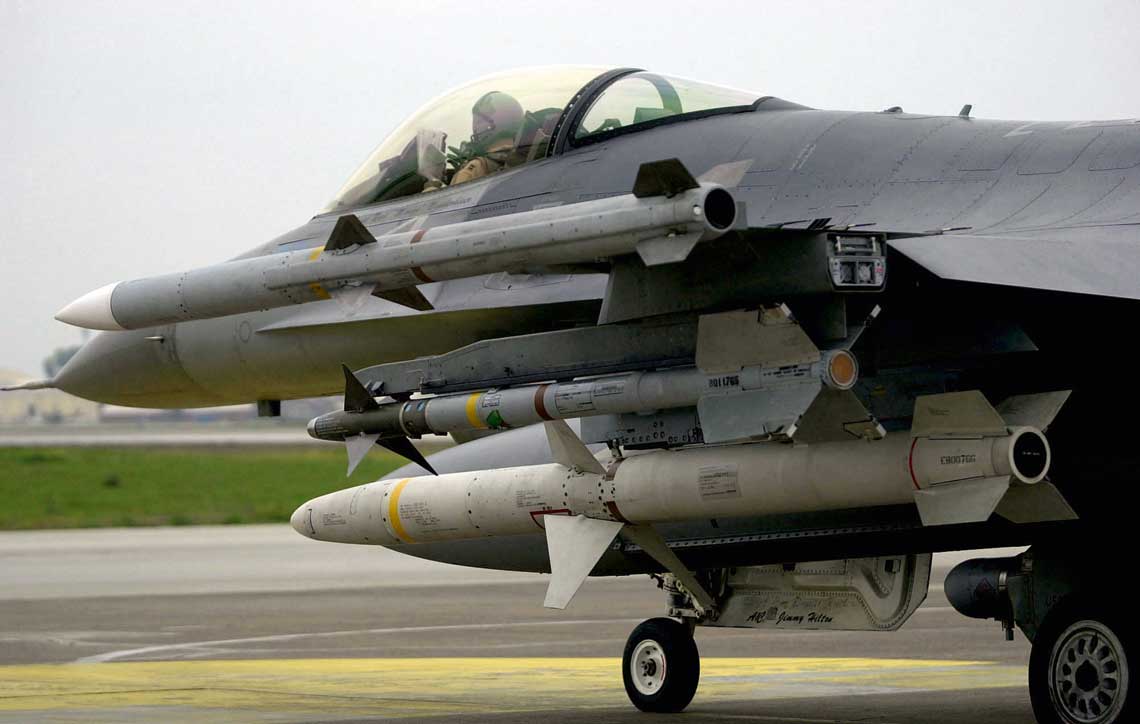
NEZ - No Escape Zone

F-16C fighter armed with AIM-120C AMRAAM medium-range air-to-air missiles (at the wingtip) and small
AIM-9X Sidewinder range.
What is the range of this missile? - this question is often asked at various exhibitions of aviation equipment. The answer is usually quite concise, like "30 km" or "up to 100 km", depending on which missile the interested party is asking about and who is answering. Less often we hear the answer that range depends on many factors, including the height and speed of the host, and cannot be quantified by a single number. The situation is even more complicated when it comes to air-to-air missiles.
The data contained in the information materials of manufacturers usually give the maximum possible value, which is actually unattainable in normal combat practice, without specifying the conditions under which it is achieved.
Materials in which the zones of possible ignition are graphically represented with their horizontal and vertical sections, or the so-called projectile shells. Usually the lack of information is explained by considerations of protection of secrecy.
This is a widely accepted rationale, since by knowing the exact data and capabilities of the projectile, effective countermeasures can be developed. However, there are enthusiasts, aviation enthusiasts who would like to know, for example, what is the real range of the AIM-120 AMRAAM guided missile.
In the article, we will try to acquaint readers as much as possible with the aspects of the operation and use of air-to-air missiles in the context of what is commonly called, but not always correctly, range.

The MBDA Meteor long-range air-to-air missile has the world's largest unguided zone, designed for at least 60 km. Its carriers are Typhoon, Rafale and Gripen fighters.
In modern multi-role aircraft, the on-board weapons control system computers are responsible for calculating the data needed to launch the missile. This information is presented graphically on displays in the aircraft cockpit and, in recent developments, on displays on pilots' helmets.
In conditions of air combat and a rapidly changing environment, efforts are being made to minimize the data issued to the crew in order to reduce information overload (pilot load), as well as accelerate its assimilation. Therefore, when using air-to-air combat missiles, it is important for the pilot to know whether the target is at the distance at which the missile can be launched or not, and whether there are other necessary conditions beyond the corresponding distance for launching the missile, or what maneuver is necessary for achieving these conditions. In this case, the flight ranges of the projectile - understood as the distances achievable under given conditions, at which the possible flight of the projectile is possible - in this case does not matter. Values called fire zones are important, they are calculated and presented to the pilot along with additional necessary information.
The difference between the range of a missile and the firing distance is due to the fact that in air combat, the target and the missile carrier move relative to each other in space, maneuvering with speed, altitude and heading. Specific ranges, taking into account maneuverability, speed and other data for a rocket fired from an aircraft under certain flight conditions - speed and altitude, can be represented in the form of a graph of space-time capabilities, called the envelope of the projectile (Fig. 1).
The boundary is determined by the achievement of predetermined end conditions of the projectile. These conditions are the maximum controlled flight time, the minimum allowable projectile velocity and the maximum allowable g-force.
The shape and dimensions of the shell are determined by such design features as the operating time and thrust impulse of the rocket engine, aerodynamic characteristics, controlled flight time, as well as the carrier speed and flight altitude at the time of launch.
The controlled flight time is determined by the maximum operating time of onboard power sources - electric, pneumatic, hydraulic, or a combination thereof, depending on the type of rocket. The minimum terminal speed is the speed at which the aerodynamic rudders still steer the projectile. Propulsion characteristics, together with aerodynamic characteristics (drag and lift), together affect the maximum speed achieved and its subsequent change in flight, as well as the maneuverability of the projectile (achieved overloads).
The flight altitude and speed of the aircraft launching the rocket are of great importance for the size and shape of the envelope. Since the missile's rocket engine provides an increase in speed, the speed at which the missile is fired, the so-called muzzle velocity, also plays a role in terms of the distances achieved. Even more important is the density of the atmosphere. At low altitudes, in dense layers, air resistance will reduce the speed of the projectile much faster after the rocket engine stops working than at medium and high altitudes. Consequently, the envelopes determined for different flight altitudes and initial speeds will differ significantly from each other.
Knowing the space-time capabilities of the projectile for current conditions and target movement parameters, the so-called. zone of possible launches (in the English nomenclature it is most often called the Missile Launch Envelope - MLE). It differs from the shell of the projectile in that it also takes into account the parameters of the target's movement - the velocity vector and additional restrictions (which will be discussed later in this article). When attacking a target on opposite lines, i.e. from the front hemisphere, the target itself passes part of the distance and this distance is added to the distance traveled by the projectile. On the other hand, when attacking on converging courses (from the rear hemisphere), the projectile must catch up with the target, so the path of the target when the projectile is in flight must be subtracted from the distance that the projectile can travel in pursuit of the target.
The permitted firing zone can be delineated and represented graphically in a variety of ways - relative to the host or the target. Most often, it is presented in horizontal and vertical sections in relation to the target, with the conditions for which it was installed.
To calculate the size of the missile launch zones, current data are used, values arising from the space-time capabilities of the missile, as well as hypotheses regarding the behavior of the target, which together affect the size of the calculated zones and the effectiveness of the attack, are accepted. Depending on the type of projectile, the minimum terminal velocities of the projectile and/or the minimum required speeds of approach to the target, the fuze actuation (arming) time, and the size of the target are also taken into account, in particular.
The current data is the current speed and altitude of the attacking aircraft and the target, closing speed and heading angles. The minimum final speed will depend on the type of projectile, the direction of attack and the flight altitude. It is usually assumed that for low and medium altitudes, air-to-air missiles are controllable in the speed range from the maximum achieved to Ma = 1,2, below which the effectiveness of aerodynamic rudders is insufficient. At high altitudes in very thin air, the minimum velocities will be greater and will depend on the projectile's aerodynamic system. Another important aspect for determining the minimum speed is the direction of attack, and hence the speed of approach to the target.
